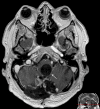Orthostatic hypotension after cervicomedullary junction surgery: illustrative case
- PMID: 36061095
- PMCID: PMC9435566
- DOI: 10.3171/CASE21448
Orthostatic hypotension after cervicomedullary junction surgery: illustrative case
Abstract
Background: Surgery at the cervicomedullary junction carries a risk of damaging vital brainstem functions. Because the nucleus of the solitary tract (NS) is involved in the baroreceptor reflex, damage to its integrity may lead to orthostatic hypotension.
Observations: A 56-year-old man with a medical history of hypertension, von Hippel-Lindau disease, and previous bilateral adrenalectomy due to pheochromocytoma was referred with symptoms of dysphagia and paralysis of the left vocal cord. Paralysis of the left vagus nerve was suspected. Magnetic resonance imaging revealed a contrast-enhancing cystic process in the cervicomedullary junction. Twenty-three years earlier, the patient had undergone surgical treatment for a hemangioblastoma in the same region. After repeated surgery, the patient temporarily developed orthostatic hypotension. At discharge, the patient no longer needed antihypertensive medication.
Lessons: Surgery near the cervicomedullary junction can affect the NS, leading to disruption of the baroreceptor response that regulates blood pressure.
Keywords: MRI = magnetic resonance imaging; NE = norepinephrine; NS = nucleus of the solitary tract; cervicomedullary junction; fossa posterior; hemangioblastoma; nucleus tractus solitarius; orthostatic hypotension; pheochromocytoma.
© 2021 The authors.
Conflict of interest statement
Disclosures The authors report no conflict of interest concerning the materials or methods used in this study or the findings specified in this paper.
Figures



References
-
- Furlan R, Magatelli R, Palazzolo L, Rimoldi A, Colombo S, Porta A. Orthostatic intolerance: different abnormalities in the neural sympathetic response to a gravitational stimulus. Auton Neurosci. 2001;90(1-2):83–88. - PubMed
-
- Freeman R, Abuzinadah AR, Gibbons C, Jones P, Miglis MG, Sinn DI. Orthostatic hypotension: JACC state-of-the-art review. J Am Coll Cardiol. 2018;72(11):1294–1309. - PubMed
-
- Gómez-Esteban JC, Berganzo K, Tijero B, Barcena J, Zarranz JJ. Orthostatic hypotension associated with an epidermoid tumor of the IV ventricle. J Neurol. 2009;256(8):1357–1359. - PubMed
Publication types
LinkOut - more resources
Full Text Sources
Miscellaneous

